A paper presented at the public session 'Engaging with Place: Ruin, Memory, Regeneration' for The Curatorial Thing: Audacious Landscapes, Copenhagen, Denmark, 7 October 2022. Organised by the SixtyEight Art Institute.
The focus of my contribution to Audacious Landscapes[1] is a research project named The fountain: An art-technological-social drama. It is, quite literally, a project about a fountain – a failed fountain – on the campus of Lund University’s Faculty of Engineering. However, as I prepared for this presentation, I added an additional title, in Swedish: “att hämta vatten” (to fetch water), and I thought I would begin with a small narrative detour as to why.
In the first months of 2020 I was engaged in thinking about two built objects I had recently encountered. One had been a grand vision, intended as a demonstration of technological and artistic virtuosity in public space; the other, a modest, far more intimate endeavour, tucked away out of sight in forest. Both objects had received determined, sustained commitment from their originators, and both had presented significant obstacles, problems, difficulties as they came into being. At some point, each of these objects had been given up on – walked away from, left – by those who had previously been so invested in them. Both are now a presence in my life in Sweden, objects to which I have now committed to, taken up, and begun to reimagine.
The first is the just mentioned fountain – the LTH Fountain – a large scale public artwork that was the collaborative vision of Swedish architect Klas Anshelm and sculptor Arne Jones. Anticipated as a modern “artistic-technological cathedral of steel, glass and water without parallel in the world”, LTH-fontänen proved to be frustrating as a fountain: leaking, fracturing and never effectively carrying water. A great deal of time and money was directed towards rectifying its design flaws and multiple mechanical failures. Anshelm and Jones’ vision was partially dismantled and finally abandoned in 1996. Now inert, and in plain view on campus, renovation is considered impracticable, and the LTH Fountain remains an unrealised project. It persists in a state of suspension, immobilised somewhere between an artwork and a ruin.

The second object in this narrative is a solitary ‘cabin in the woods’, a husvagn, in Marks kommun near Gothenburg, Sweden. This object was the vision of a young man named Anders who had a simple worker’s barrack transported from Stockholm, by road and by tractor, to a clearing in the forest on a friend’s land. Without possessing any building skills, practical know-how, or electricity, Anders set about single-handedly transforming it into a place to live. He built a new roof, added the second floor ‘tower’, installed a wood burning stove and solar panel. He cut trees, built a woodshed, and started a garden.
Yet one day, after three or four years, he left and never returned, leaving most of his things in the cabin. A decade or so later, I made my first visit there with my husband Julian. Some dampness and families of mice had made their way into the walls, and swollen cans of beans on the shelves lay ready to explode, but in general there was a sense we had caught it in time, and no evidence of impending structural collapse.
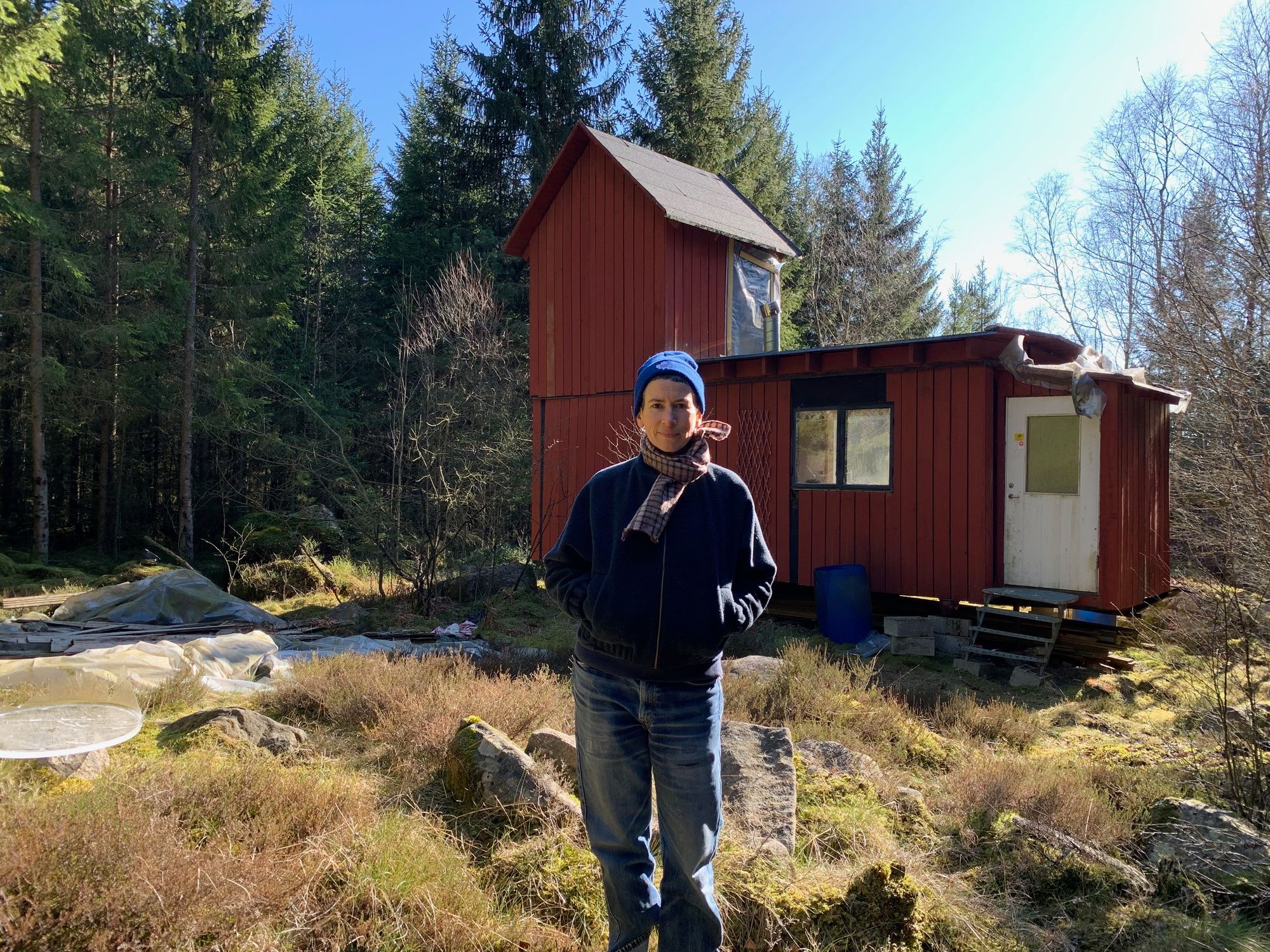
And so it was that we took up where Anders had left off – inheriting his tools, building materials, kitchen utensils, a table, and a large pile of chopped wood. Sorting through his things, we found a carefully prepared “to do” list, delicately coloured in pink, blue and yellow. It offers a curious meditation on practical tasks and imaginative desires: chores such as “putsa fönster” (clean the windows), “städa och soppar hallen” (clean and sweep the hall) and “kompost” sit in noticeable contrast to “planta luktärt” (plant Sweet Peas) “gå skogspromenad” (walk in the forest) and, most particularly, “göra sängen till en rosa dröm” (make the bed into a pink dream). Completed tasks are dutifully noted as a full black square; incomplete tasks are marked with a diagonal line. It seems Anders achieved quite a few on his list, and Julian and I have contributed to the completion of others, such as “göra i ordning / sortera vedlåda” (put in order/sort the woodshed).
Recently, when I looked at this list again, I noticed the only item that appears twice is “hämta vatten” (fetch water), a small but poignant reminder as to the constancy and necessity of this task in sustaining daily life.
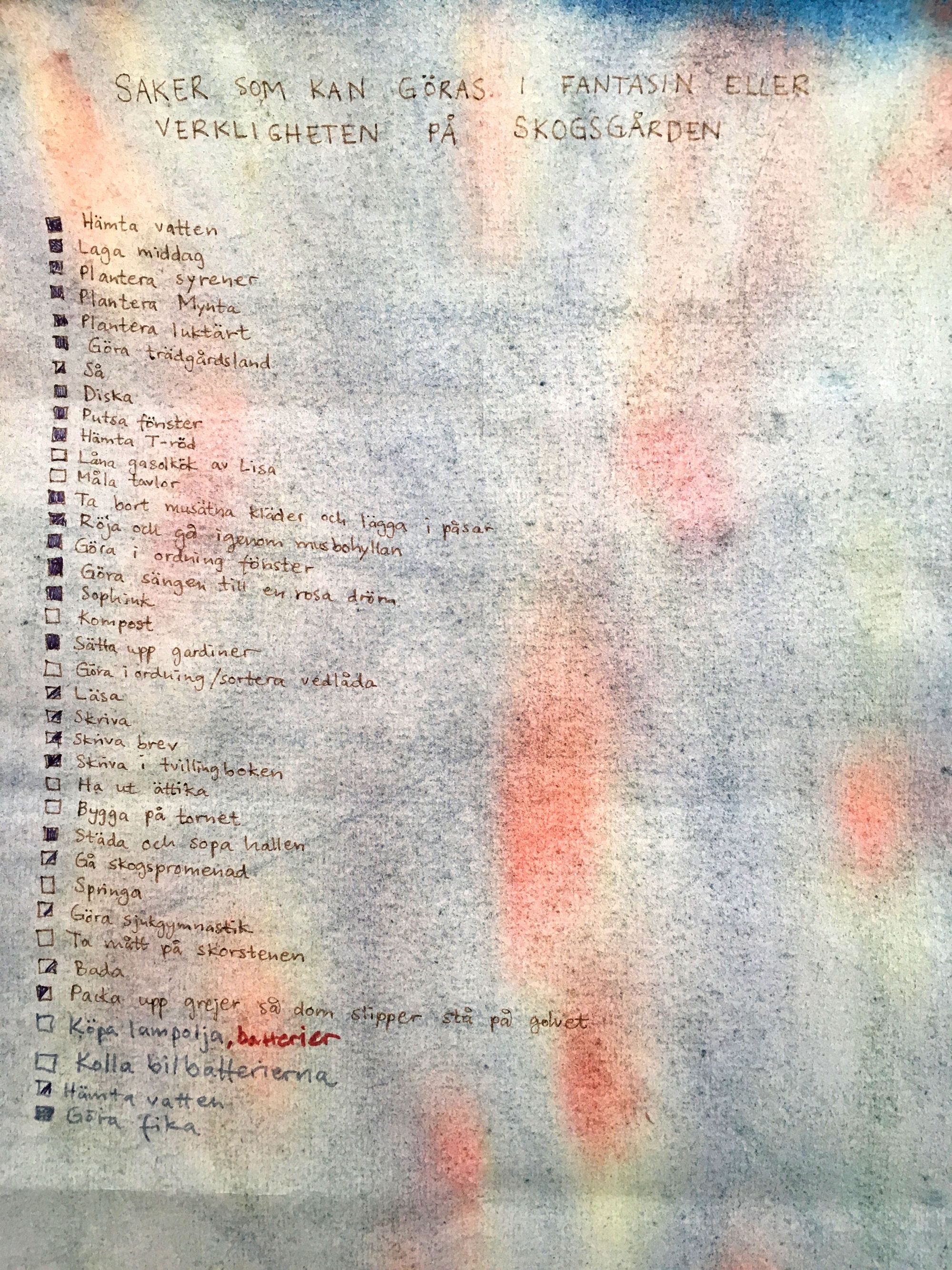
What I am interested in here, in my relation to these objects and their various demands on my attention, is how they both lead me to deliberate on a problem, that of: what does it mean to give up on (something), and what does it mean to take up (something)? Certainly, the consequences of my involvement in these two projects are entirely different – one is an object that has received great public scrutiny, inciting scorn, sarcasm, or fervent devotion to differing degrees. Significant amounts of capital investment and public money have been spent on it. Its initial failure and slow demise have taken place in plain view on a university campus.
Whereas the state (and fate) of the cabin is of little consequence to anyone else. In the same way no one sees a tree fall in the forest, it could, undramatically, become a composting mound of mossy, decaying boards and rusting steel. Yet, the cabin has emerged as a micro companion to the larger, much more visible fountain project, as another site where I encounter questions of authorship, continuation, and regeneration, but at an entirely personal scale. This is why, when I began thinking about the topic for this evening – Engaging with Place: Ruin, Memory, Regeneration – it seemed apt for this small project to sit here, on screen, alongside the main subject I nominated to talk about, and perhaps we can return to it later.
In May 2020, The Fountain: An art-technological-social drama was the title I gave to a funding application I submitted for a national research call in Sweden towards “Gestaltad livsmiljö” or Designed living environment – architecture, form, design, art and cultural heritage in a public environment. My application was developed around a (seemingly) simple central question: At what point can a public artwork be revitalised and thought anew?
If the answer is yes, a public artwork can be reimagined, other questions immediately arise that unsettle concepts of artistic authorship and ownership, and the evaluation of public artworks in terms of “success” or “failure”. What are the implications for cultural heritage and public consultation? Do public artworks have similarities to monuments, where societal change can produce an ethical dilemma around their visibility and duration? Is there a sustainability principle that can operate as an alternative to abandonment or removal of public artworks – and, are there ways of demonstrating that something new can emerge from capital and material investment that has already taken place?
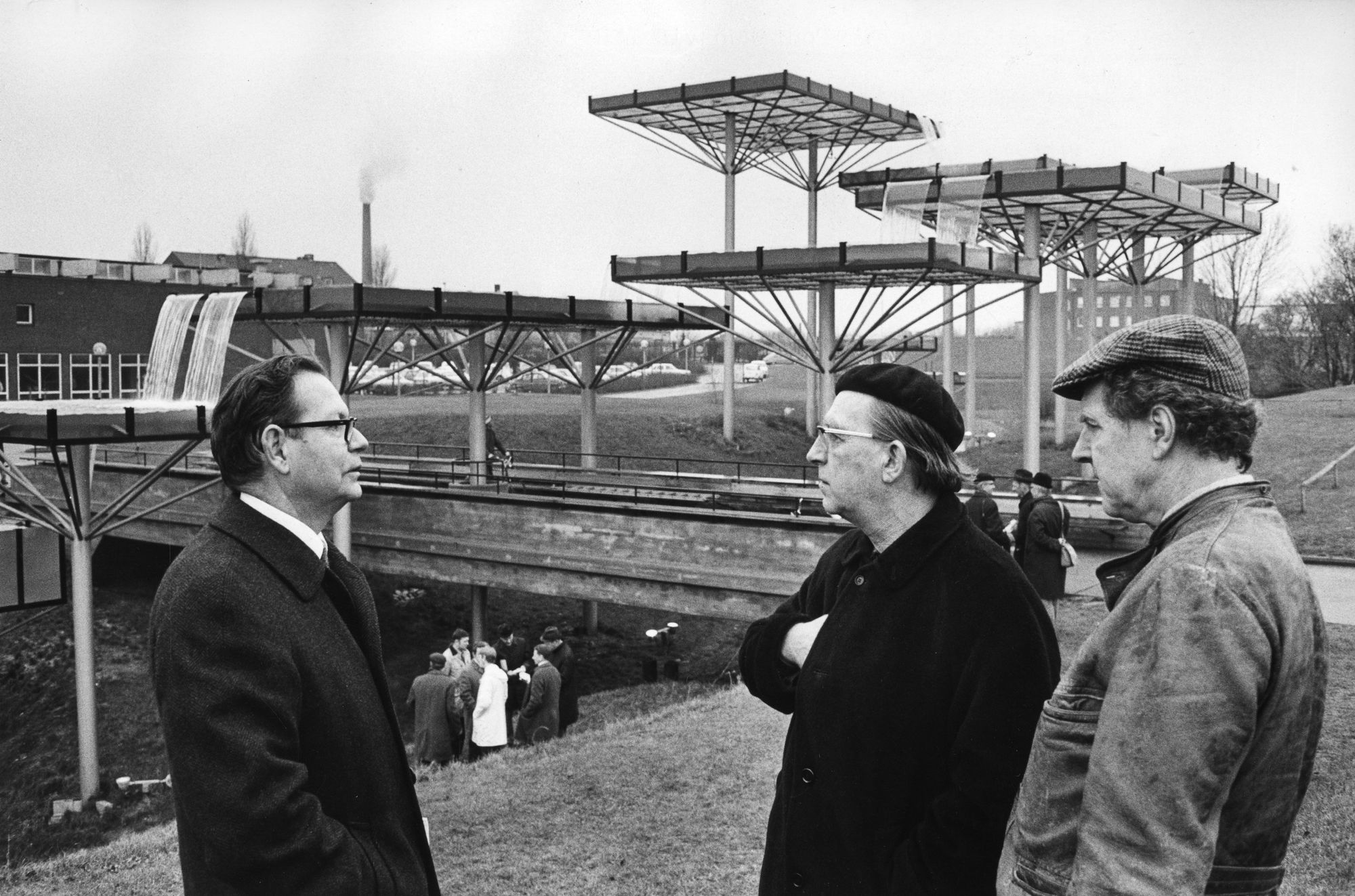
My somewhat literary title for this research application was borrowed from an email written to me by Jan Torsten Alstrand – art historian and former Director of the Skissernas Museum of Artistic Process and Public Art in Lund – in which he had enthusiastically described the LTH Fountain in Lund as a “long-lasting art-technolgical-social drama” and “The Great Symbiosis of Art and Technology!”
In that same email he also wrote:
It is more than twenty years now since I heard anything about the LTH fountain, so I am very surprised that there suddenly is an artist from the other side of our planet, now here in Sweden, who is interested in this great but failed public sculpture in Lund. How come?
Good question. I can answer this, in part, through the simple fact that the letters ‘L T H’ and the word “fountain” are bound together in the name of the object itself. The abbreviation stands for Lunds Tekniska Högskola (Lund Institute of Technology) and is still commonly used, despite being formally renamed Lund University’s Faculty of Engineering in 2005. Built in the early 1960s, the campus now hosts a formidable range of subjects including Mathematical Sciences, Energy Sciences, Water and Environmental Engineering, Construction Sciences, Fluid Mechanics, Innovation Engineering, Industrial Design, Architecture and Built Environment to name a few. Locating the LTH fountain between two ponds near the F and D buildings – F for fysik (physics), D for datorvetanskap (computer science) – it was architect Klas Anshelm’s intention that this large-scale sculpture would form the centerpiece for the most advanced technological campus in Sweden.
In 2023, the European Spallation Source (or ESS) will be completed as a major new university site directly to the north of the LTH campus. Promotional texts announce it as “a multi-disciplinary research facility based on the world’s most powerful neutron source,” enabling university researchers to “study the materials of everyday life, from plastics and proteins to medicines and molecules, in order to understand how they are built up and how they work”.[2]

The LTH Fountain, commissioned for what was once the geographic centre of technical research in Sweden, is now a ghostly figure on the periphery of such ambitions. One could say its failures have symbolically, almost absurdly, subtracted it from the rhetoric of “knowledge production”.
Embedded in the history of the fountain are unverified rumours and competing narratives of blame. Structural engineers, architects, art historians, journalists and students have offered different theories on its faults and failings, including vandalism of its glass basins by slingshot and air rifle. The LTH Fountain, quite simply, did not collect and circulate water as it should. Rather, water leaked and streamed steadily from its edges. In strong winds, the vibration of its tall columns caused waves to gather momentum and rain down on passersby. In their design for the fountain, Klas Anshelm and Arne Jones had insisted on using a particular type of Belgian raw glass in the construction. Their idea was that one would gaze upwards through crystal clear moving water to the sky beyond. In 1969, the difficulty of achieving this spotless view was already evident through the steady accumulation of leaves and pond water sediment.
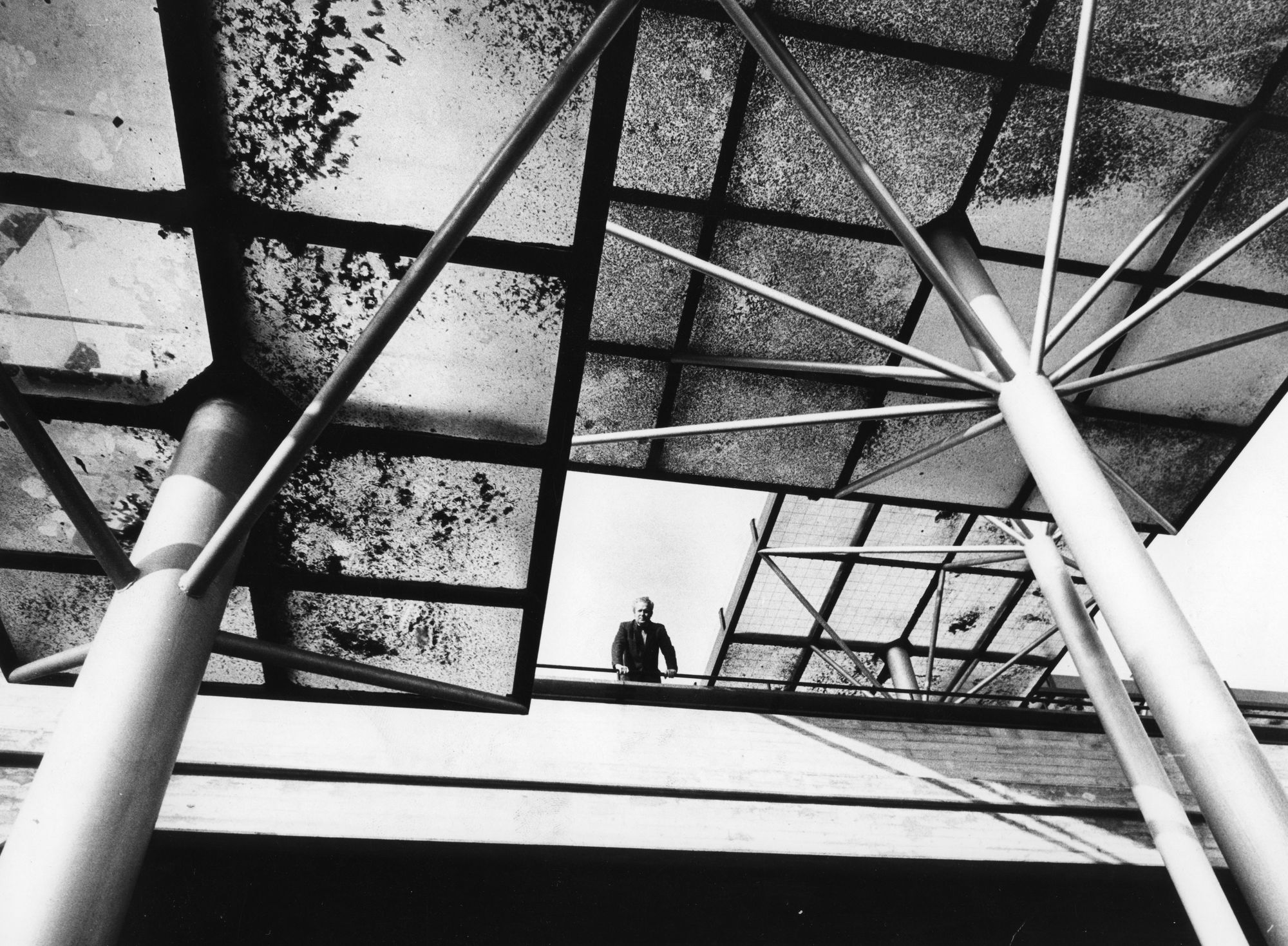
Jan Torsten’s “How come?” is also answered by simple curiosity about elusive references to a small miscalculation in the fountain’s construction details by a mathematics professor employed by the niversity at the time. Who was this professor? And what was the mistake that consequently transformed LTH-fontänen into “the dead falls”, the “salmon ladder”, the tragi-comic figure of “Fontänen von Tänen” or “Fontana di träti”? My initial desire was to uncover the mathematical oversight that carried unforeseen “catastrophic”[3] consequences for this artistic work, and to amplify its possibilities within the reimagination of the LTH Fountain. Increasingly, what has emerged from this curiosity is a growing sense of deliberation on what I described earlier as acts of “giving up” and of “taking up”.
Both these terms have some resonance with my PhD, completed last year, in which I wrote about cooperation between commitment and uncertainty in my own artistic projects. It was words such as fidelity, obstinacy, faithfulness in aspects of the work of British philosopher Simon Critchley and French philosopher Alain Badiou – which they link to their particular conceptions of ethics – that has helped sharpen my interest in the LTH Fountain and the evidence of a sustained and committed endeavour around it. I share Badiou’s fondness for Samuel Beckett’s characters in Waiting for Godot and their stubborn persistence as they wait beside a lamp, a tree, a park bench (or, in this case, let us substitute a fountain) but, importantly, Badiou describes fidelity as active, as something processual which is both discerning and disciplined, in which “there is no general faithful disposition . . . (fidelity is not) a capacity, a subjective quality, or a virtue. . . .Rather, fidelity is a situated operation which depends on the examination of situations.”[4] He positions this process of commitment as requiring the capacity to make decisions from the point view of what is, as yet, unknown; to decide from what is undecidable.
The fountain as an undecided object
It is well recognised that public artworks in urban spaces are frequently the subject of contestation and criticism, causing controversy for their cost, where they are situated, their aesthetics and purpose. In her brilliant online project Archive of Destruction, Jes Fernie uses categories such as decay, boredom, fear, entropy, greed, love, conviction and rage to map the destruction and disappearance of public artworks. Sometimes artworks successfully endure in their communities for generations; on other occasions public pressure, or issues of maintenance, result in removal. As a creative endeavour, LTH-fontänen is certainly not alone in falling short of its creators and commissioners’ ambitions, however it is unusual for having survived fifty years as a largely unrealised project.
In her doctoral thesis, Swedish art historian Jessica Sjöholm Skrubbe identifies how public artworks commissioned in Sweden’s folkhemmet (a term associated with the Swedish Welfare State over a 40-year period from the 1930s to 1970s) produced “a highly gendered power structure, as the practice of public sculpture became a male monopoly.” LTH-fontänen, commissioned in the 1960s by the Swedish Public Art Agency is no exception. Driven largely by the artistic ambitions of Klas Anshelm its story has unfolded around an almost exclusively male cast of characters.
On occasion, I’ve been told that Anshelm and Jones were close friends who drank together regularly, and the suggestion has been made that their fountain design was modelled on a champagne pyramid – a story that supports an image of male camaraderie, hubris, and social privilege, but one I also enjoy because it lightens the weighty claim for artistic-technical virtuosity that has shrouded the fountain. Yet, if we take these ambitions seriously, enacted through a distinctive modernist regime of geometric abstraction, scale, hierarchy, and industrial materialism – what future did the fountain anticipate? What optimism did it assume? What latent ideology did it rest upon? These questions become more interesting, and are made more complex, by the relative immediacy of the object’s failure. It is not that its ambition failed slowly, gradually, a result of normal wear and tear. Rather, this object failed abruptly, clearly, publicly – in plain view of its originators, its commissioners, and champions.
Klas Anshelm died in 1980 and Arne Jones in 1976. From the outset, Klas didn’t like to speak about the fountain’s problems. However, one of the final suggestions he made was that all the fountain’s glass could be replaced with sheet metal – a proposal which makes a significant aesthetic compromise and suggests a sense giving in, if not exactly giving up. Plagued by design issues and claims of repeated “vandalism” by slingshot and air rifle, by the mid 1990s both the cost of repair and the cost of removing the fountain were considered too high to be practicable.
In a committed effort, a small group of local Anshelm supporters and students from the LTH student union organised one last public “drive” of LTH-fontänen on the 18th of August 1996. Jan Torsten Ahlstrand was there and described it as “Against all odds, the technology corps managed to bring about a final run of the fountain…It was a beautiful summer Sunday, and the event took the form of a folk festival with speeches and Verdi's Requiem roaring from the speakers.” In his speech that day, LTH's rector Thomas Johannesson is reported to have declared: "It is not art that has failed, it is technology."
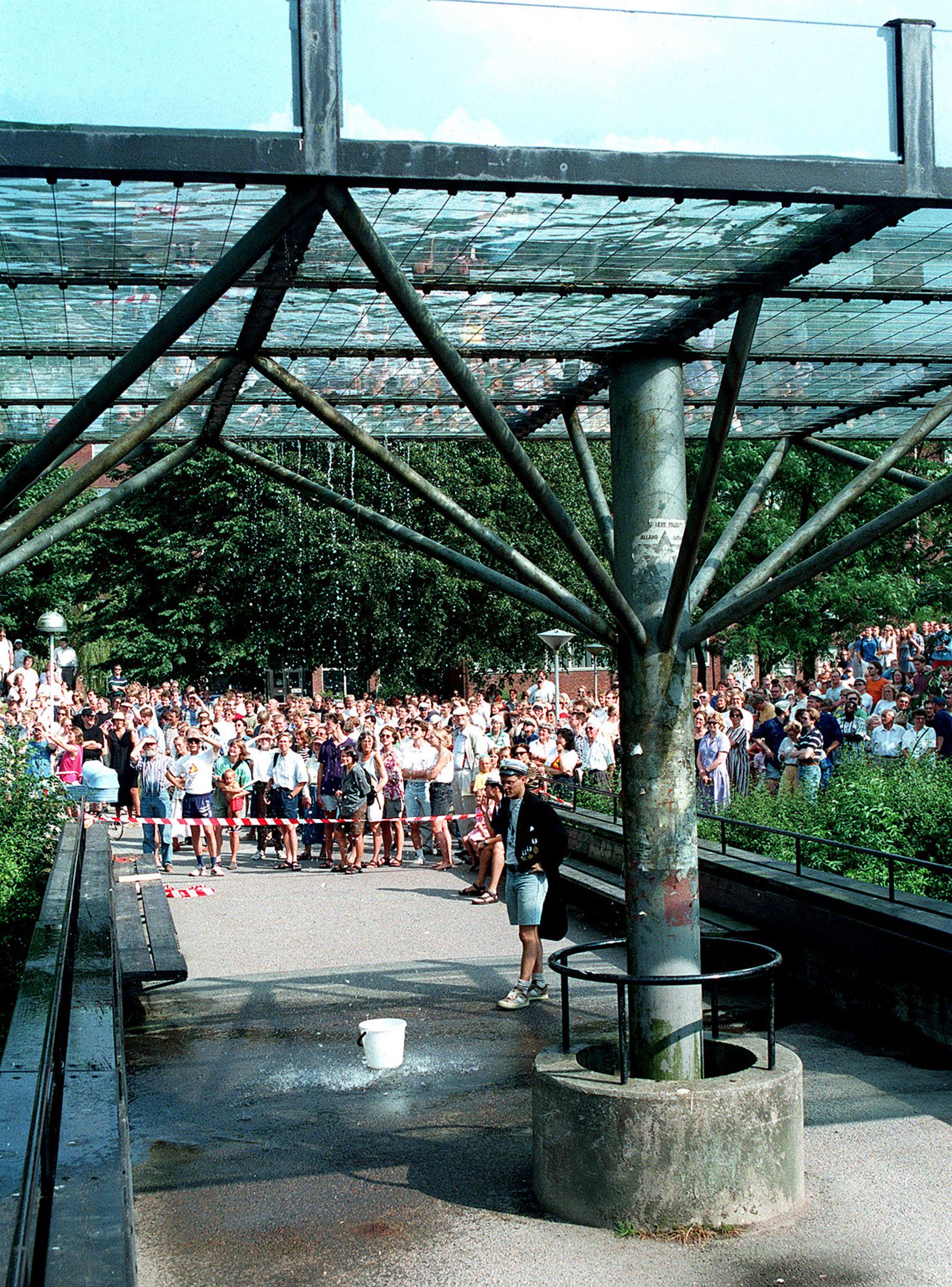
Twenty-five years ago, these fountain defenders argued for something akin to placing a body in cryonic suspension – a form of future-proofing in which the fountain would eventually be reanimated with technological solutions yet to be developed. One could say they anticipated the taking up of Anshelm’s and Jones project by unknown future protagonists. At the time, the dilemma of what was to be done with the fountain ended in a decision that took the middle road. Neither repaired nor removed, the fountain was partially dismantled – all glass components were removed but much of its skeletal structure was left intact. The fountain has since been ‘maintained’ in this state by its official owners, Akademiska Hus (a Swedish government enterprise for educational real estate), who see their role as one of keeping surrounding vegetation at bay and removing any posters attached to its columns. In this way, LTH-fontänen was left to offer an image, a sketch, a mirage of the idea of the fountain, rather than an actuality, persisting in a state I have described as neither an artwork nor a ruin.
To give up
In 2022, sensing a faint pulse emitting from the LTH Fountain, it is the reactivation and continuation of decision-making processes in relation to this object that I am interested in catalysing. With my colleagues in the project, we have started to think about whether a seemingly benign public artwork such as the fountain can be related to discussions encircling more malignant public objects such as civic monuments, memorials and statues. The last decade has seen the intensification of protest, increased media coverage, and successful public demand for the removal of confederate monuments in the USA, colonial and settler monuments in South Africa, Canada, Australia and New Zealand, also merchants, slave traders and figures of authoritarian and oppressive rule elsewhere around the globe. Profound questions about who, why and for “how long will this statue be here?” have gained momentum and are increasingly difficult for city managers, public institutions, and politicians to ignore. In some places, these objects are being voluntarily handed over, destroyed, mothballed. These progressive acts can be aligned with definitions of “to give up” such as: to stop owning, using or claiming something; to admit defeat, to stop having a friendship with; to hand oneself over to the police; to give up for dead.
If we avert our gaze from those men on plinths, armchairs and horses who remain in our cities, our eyes may come to rest on other objects populating our parks, universities, city squares, waterfronts, playgrounds, housing developments and transport interchanges. These are also public objects, often commissioned without consultation and with intentions of permanence or longevity.
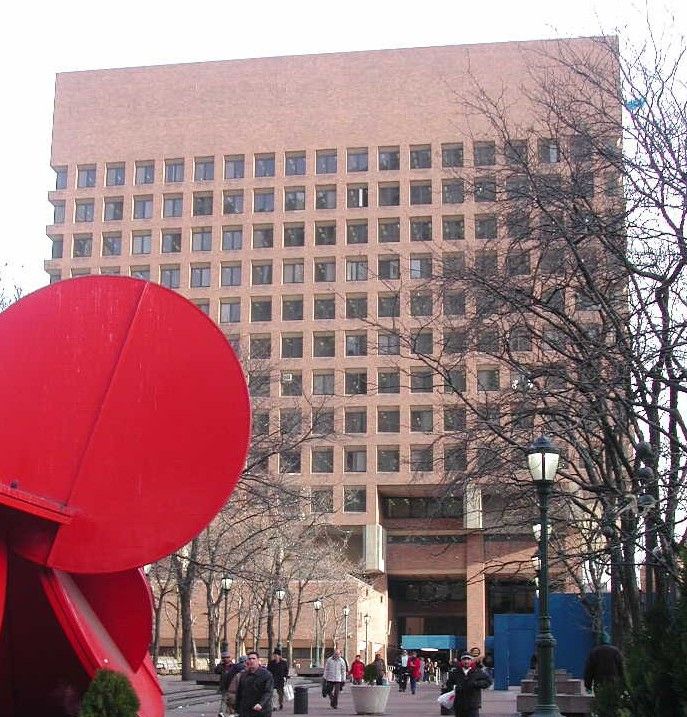
In the field of public art, despite permanency having been challenged by the development of temporary artistic projects that draw on performative strategies, 'happenings' and socially engaged practices, it could be argued these developments have had limited impact on the everyday commissioning of public artworks. Expectations of physical presence and material longevity remain relatively entrenched requirements for artistic objects in many architectural and designed environments. In Sweden, for example, this would typically be percent-for-art commissions connected to public and private building projects. In addition, the long-term custodianship and care of these objects – for contractual periods of anywhere between 20 and 50 years – is often considered less than satisfactory.
Conditions of care, continuity and commitment are perhaps most evident when it comes to situations where water is a component of public artworks. It is not uncommon to observe its absence after decisions have been made to turn off the taps. Indeed, a small part of my research process now includes building an archive of dry public fountains. Many are more modest in scale than LTH-fontänen, but they have begun to form a set of companion objects; a community of the failed and the water-less. Construction complexities in relation to water or “practical hydrodynamical problems” – to get water to circulate, to defy gravity, to flow in multiple directions – mean that fountain endeavours are also vulnerable to performance issues and risk being given up on. In an essay about 18th century mathematician Leonhard Euler’s failed fountain design for the King of Prussia at Sanssouci, Michael Eckhert notes how it quickly became a symbol for the schism between theory and practice, revealing a fundamental gap in understandings of “ideal versus real fluids”[5].
I also want to briefly acknowledge some potential similarities abandoned or failed fountains may have with a cultural phenomenon known as Hyperart Thomasson. Now considered a conceptual art movement of sorts, it emerged in Japan in the 1970s when artist Akasegawa Genpei began identifying preserved architectural relics in the urban landscape, which served no apparent purpose. The movement was subsequently named after American baseball player Gary Thomasson who, in 1980, signed a highly lucrative professional contract with Japan’s Yomiuri Giants and then promptly set a record for the most strikeouts in a single season and was relegated to the bench.

To take up
Earlier I used the word benign to describe certain types of public objects / artworks in our cities – objects less likely to provoke questions about suspect ideologies and demands for their removal in the way that monuments and memorials can and, increasingly do. Instead, these objects encounter a form of public inattention – something that is perhaps most pronounced in the sorrowful image of the fountain-without-water but is certainly not exclusive to it.
So, what would it mean to return to these objects and re-attend to them? I was interested in the idea of “Ruderal Futures” that Alex Young put forward in their presentation for Audacious Landscapes, framing the question in a different way: “how do we live with things that are where they are?” This brings me back to the act of taking-up that I began with this evening. It’s not that I am proposing a manifesto for the artistic re-imagination or re-authorship of every old, failing or poorly maintained public artwork. Rather, I see LTH-fontänen as a testing ground for troubling duration, artistic authorship, sustainability, and cultural heritage that may also be relevant to public artworks in other situations.
I think of The fountain: An art-technological-social drama as an inherently optimistic project with the potential to activate something beyond, more than, and counter to the figure of a failed public fountain – to take up, détourne and (even) celebrate failed investment, failed production, failed mathematics, failed architecture, failed art, failed engineering, failed materials, failed effort, failed authorship, failed performance, failed publicness. It is here that I recognised a tangential connection to the thematic ambitions of this iteration of The Curatorial Thing: Audacious Landscapes which states:
“…we read “audacious” as a paradox of both capitalist hubris and the risk of imagining better possible afterlives; we consider “landscape” beyond framed artworks in museums, as art objects take on new roles in the public sphere…from art histories of grief to imaginative proto-histories of thriving in profoundly changed ecosystems.”
Footnotes
[1] Audacious Landscapes was held 01-08 October 2022 in Copenhagen, Denmark. It was the fifth edition of The Curatorial Thing, an annual international symposium and working group initiated and organised by the SixtyEight Art Institute. Keynote speakers included T J Demos, Andri Snaer Magnason, Diedrich Diederichsen and Darren Parry. Other participants included Marianna Tsionki, Alex Young, Animali Domestici, Ariana Kalliga, Catherine Sarah Young, Elias Kurdy and Luamba Muinga.
[2] See “European Spallation Source”, https://www.lunduniversity.lu.se/research-innovation/max-iv-and-ess, and https://europeanspallationsource.se/about.
[3] A newspaper article about a “test-drive” for the fountain uses the Swedish word “katastrof” in its headline. “Miljonskulpturs glaslådor katastroftöms automatiskt”, Sydsvenksa Dagbladet Snällposten, 19 June 1968.
[4] Alain Badiou, “Meditation 23: Fidelity, Connection”, Being and Event (London: Continuum, 2005), 233.
[5] Michael Eckert, “Euler and the Fountains of Sanssouci”, Archive for History of Exact Sciences, No. 6 (2002): 45

